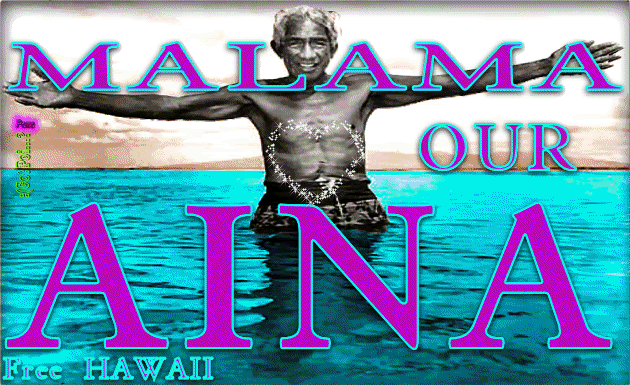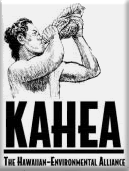Aina (7)

http://www.makaihawaii.com/makai_preview_tiab.html
 Tia Blankenfeld: A Heart For The Community
Tia Blankenfeld: A Heart For The Community
By Alison Stewart
Growing up around the Hokule‘a and the ocean all her life, Tia Blankenfeld has water running through her veins. As a very busy 25-year-old young native Hawaiian woman, she also doesn't waste a moment of her time as she clearly has a heart for the community and helps with countless projects. With everything on her plate, Blankenfeld barely has time for herself, yet still makes it her number one priority to finish law school.
Blankenfeld's curiosity of law was sparked when she was very young because of her family's land ownership.
“I grew up in Niu Valley and my family owns a lot of the land back there,” she says. “The Niu ahupua‘a (land division) was given to my great grandfather by his mother when she passed away.
Over the years some of the land was given away, sold, etc. by him. Then after my great grandmother passed away, we got hit with a huge estate tax (aka the “death” tax) and were forced to sell part of our property and move further up the valley.
"But that's just one of the many legal issues the family faces right now,” she adds. When Blankenfeld was about 15 years old she began attending the family meetings, and all this is what peaked her interest in law. With one year left to go at the William S. Richardson School of Law at the University of Hawai‘i, Blankenfeld keeps herself busy as one of the alaka‘i (student leaders) of the ‘Ahahui o Hawai‘i (The Hui). Its mission is to ‘accept and fulfill our kuleana (responsiblites) by providing a safe and respectful forum to discuss issues from a Hawaiian perspective that is pono (morally correct). The Hui is the oldest student organization of the law school and raises significant issues of concern to native Hawaiians at the school and in the community.
“We do a lot of educational things such as symposiums and other talks,” she says. “We try to educate people on different legal issues that affect native Hawaiians. So far, I've been doing this for a year and a half and it involves a wide array of things,” she adds.
Blankenfeld recently participated in a symposium regarding native Hawaiian tradi-tional gathering rights and was sent on a trip to New Mexico, for the Federal Indian Bar Association's annual law conference. Blankenfeld's edu-cational experience has been enhanced by the Law School's recent receipt of a federal grant from the U.S. Department of Education. The grant helped establish the Center for Excellence in Native Hawaiian Law. It focuses on education, research, community outreach and the preservation of his-torical, legal, traditional and customary materials. It also offers new courses that support native Hawaiian law students. Working as a research assistant for one of the Hawaiian rights professors, Blankenfeld tries to put in at least 10 hours a week.
“Last summer my research partner and I studied a number of Indian tribes, she says. “We compared and con-trasted their government structures, land base, memberships and different laws. That was very interesting,” she adds.
This year Blankenfeld was given the opportunity to help write a new chapter in her professor's book on the Native Hawaiian Healthcare Act. Add this to her heavy 17-credit class load, and she just wants to breathe sometimes.
“I feel sometimes I never get a break between research, reading and studying,” Blankenfeld smiles. “Plus I have one of those writing intensive classes where I have to pick a topic, do all the research and write 30 to 40 page paper by the end of the semester. It's defi-nitely a lot of work and can definitely be overwhelming at times,” she adds.
When Blankenfeld completes law school, she will focus on trusts and estate planning. In addition to her hectic class schedule and school activities, Blankenfeld still manages to make time for her paddling and coaching. She paddles about three or four times a week (usually on one-man runs) and coaches the Novice B Men group two to four times a week. The Novice B group consists of the newbies with no paddling experience, whereas people in the Novice A group have paddled for at least a year.
“Although I usually coach the young girls, this year I decided to coach adults,” she says. “In a way, the adults are a little easier to deal with because they are there because they want to be there, and not because it's something they have to do. I really enjoy coaching brand new people, who don't have any knowledge of paddling. They're very moldable and haven't picked up any bad habits yet. Plus, it's fun teaching them all the different parts of the canoe and protocol,” Blankenfeld adds.
Blankenfeld has been paddling for 15 years, since she was about 10. Both her parents were coaches, so both her and her older brother got into it. When she made it to her fresh-man year in high school, she joined the Hawai‘i Canoe & Kayak Team, and competed in K1 competitions. Her team made it to various national competitions and traveled all over the mainland to compete. Blankenfeld and her partners were literally a tenth of a second away from making it into the Jr. World Championship competi-tion one year.
“Around my junior or senior year in high school I came in second and was ranked second in the nation,” she says. “We were training with the Olympic kayaking coaches from New York and highly encouraged to continue and try out for the Olympics. But, I decided to go to college instead. I wanted to have a normal life, and this would have been a huge commitment,” she added.
Though Blankenfeld paddles one-man, she prefers paddling with her six-man team. “The whole fun of paddling for me is you get to be in the water with your friends,” she says. “We always laugh and have a good time. But something I'd like to do eventually on my own is kayak the Moloka‘i Race. I've always wanted to do it when I was younger but I since I went to college on the mainland, I never ended up doing it,” she adds. “I'm just a total water person,” Blankenfeld smiles “I just love the ocean in general and all water sports, or any-thing that has to do with the ocean. When it comes to land, I'm very uncoordinated. I grew up surfing, bodysurfing, fishing and diving. I basically did everything my dad (Bruce Blankenfeld) did while I was growing up. While I was in high school, I'd go on the Hokule‘a for day sails and go with my dad to any long distance canoe races he was escort-ing,” she adds.
Blankenfeld is also the niece of Nainoa Thompson, the executive director of the Polynesian Voyaging Society, and a Hokule‘a pioneer. She is extremely fortunate to be able to take advantage of what her family's legacy has to offer her. “I dabble in a little of everything,” Blankenfeld laughs. “I'm involved with everything that has to do with the Polynesian Voyaging Society and Hokule‘a. I especially help my mom (Lita Blankenfeld) since she is in charge of all the food that goes on the Hokule'a voyages and does a lot of the legwork for Uncle Nainoa. If it weren't for her, Hokule‘a would probably never leave Hawai‘i. My mom is always in the back-ground doing something. She's also an amazing paddler, a good athlete, and the best steersman in the family,” she chuckles.
Traveling is also a big part of Blankenfeld's life. Especially with Hokule‘a in her family, she has been given the opportunity to go all over the world. “My brother and I have been to a lot of places while we were growing up because my dad, uncle and basically the whole family was involved with the Polynesian Voyaging Society,” she says. “When we were little, my mom would take us to all the different places H¯ok¯ule‘a went.” Blankenfeld has been to New Zealand, Tahiti, Cooke Islands, The Marquesas Islands and Samoa to mention a few.
One of her most memorable experiences was going to the north side of Moloka‘i, paddling to different beaches and hiking around different valleys. However, her favorite by far was her adventure in Europe with her high school best friend. Together they spent a semester in Italy, had four-day weekends every week, and visited just about every country in Europe. Blankenfeld is a graduate of Kamehameha Schools, went to Pepperdine University in California, transferred to George Washington University in Washington D.C., then earned her bachelor's degree there in environmental sci-ences. She ended up staying in Washington D.C. for two years when she received the opportunity to work in the U.S. Senate.
“I worked for the Chief of Staff, and I started off as a secretary, then worked my way up doing a lot more,” Blankenfeld says. “I worked on native Hawaiian health and education legislation with him since that was his focus. Unfortunately, I didn't get to go sit through hearings like a lot of the interns did, but I did go to different cancer research centers around the country to see which one Hawai‘i should model after,” she added.
Blankenfeld came home about two years ago when she was accepted by the UH Law School. Since her return home, Blankenfeld has enjoyed Hawai‘i's refreshing tight-knit community and open arms from her family and friends. When she fi nishes law school soon, she will continue to spread her warm aloha throughout the community.
 CALL TO ACTION: SAVE HALOA, NO GMO KALO HEARING ON MARCH 19, 2008.
CALL TO ACTION: SAVE HALOA, NO GMO KALO HEARING ON MARCH 19, 2008. MAJOR MILESTONE: WE GOT A HEARING!! Because of your dedication to protecting Haloa, Legislators felt the pressure to hear SB 958. Your words of aloha for Haloa are needed now to pass a 10-year moratorium on the genetic modification and patenting of all taro.
Here's how you can help for the March 19th hearing:
1. Submit Testimony Now: click here to go to KAHEA's virtual testimony table.
Your testimony should be in your own words, if can (legislators don't seem swayed by form letters).
Even better, if you are part of an organization or business that supports Kalo, then put your testimony on letterhead.

2. Call Rep. Clift Tsuji and the Agriculture Committee members (click here for phone numbers), tell them:
- thank you for holding a hearing on SB 958
- please do not delay decision-making on the bill
- the bill should protect all varieties of Kalo, not just Hawaiian varieties
- the moratorium must be at least 10 years or longer
3. Write a Letter to the Editor of your local paper or click here to send a letter to the two islands-wide daily papers.
....click here to learn more about how you can help!
 A MUST READ: "Uncertain Peril" is a powerful reminder that what’s at stake right now is nothing less than the nature of the future.
A MUST READ: "Uncertain Peril" is a powerful reminder that what’s at stake right now is nothing less than the nature of the future.“If we want to save places, people, or plants, we have to remember their stories. In their stories are the details of their natural and social history and, most importantly, the meaning they have for our lives...The reason traditional cultures are so important to the world right now is that they still know how to remember their stories. ” - C.H. Cummings, chapter 10.
Airing all month long on Hawai‘i's public access cable networks:
"Islands at Risk: Genetic Engineering in Hawai‘i", a new film by the filmmakers who brought us Mauna Kea: Temple Under Siege. To learn more, visit Na Maka ‘o ka ‘Aina.
Yet Another Victory Hawai‘i’s Fragile Environment!
Federal Court ruled in favor of KAHEA’s challenge to USDA’s failure to protect the environment from impacts of open field-testing of plants genetically engineered to produce pharmaceuticals.
On Aug. 10, 2006, Federal Court Judge Seabright held that the United States Department of Agriculture (USDA) and the Animal and Plant Health Inspection Service (APHIS) violated both NEPA and the ESA by authorizing Monsanto, ProdiGene, Hawai'i Agriculture Research Center, and Garst Seed to field test crops genetically engineered to produce pharmaceuticals. Read the Court's Decision, get an overview of the case, and learn more: visit the Union of Concerned Scientists, read the executive summary to "A Growing Concern."
Appellants include KAHEA, Center for Food Safety, Friends of the Earth, and Pesticide Action Network North America.
Earthjustice senior attorney, Paul Achitoff argued the case. The judge will hold a hearing on August 22nd to determine further restrictions and conditions. Please attend and show support for strong protection.
News Coverage:
- Halt on all biotech permits sought (80k PDF) Honolulu Star-Bulletin August 23, 2006.
- USDA in trouble with courts relating to genetically modified pharmaceuticals on Molokai (132k PDF) Molokai Times August 16, 2006.
- Gene-Altered Crops Denounced (68k PDF) The Washington Post August 16, 2006.
- Permits for biopharming deserve strict standards (96k PDF) Honolulu Star Bulletin Op-Ed August 16, 2006.
- Ruling paves way for crop oversight (76k PDF) Honolulu Advertiser Op-Ed August 16, 2006.
- Ruling hailed by opponents of genetically altered crops (80k PDF) Honolulu Star Bulletin August 15, 2006.
- Ruling a slight setback for biopharm growers (100k PDF) Honolulu Advertiser August 15, 2006.
KAHEA is party to a lawsuit against the U.S. Department of Agriculture seeking comprehensive regulations and protection from the field testing of genetically modified organisms.
- Earthjustice wins lawsuit on public disclosure of field trials. (24k PDF) August 5, 2004.
- Government forced to disclose locations of test sites of biopharmaceutical crops (92k PDF) November 13, 2003
- State sued for refusing to disclose GMO test site information(88k PDF) Earthjustice Hawaii Records Lawsuit Press Release, July 23, 2003
- Case Outline and Notice to Sue (239k PDF) Center for food Safety, March 3, 2003
- USDA Issues Weak Biopharm Regulations (120k PDF) Center for Food Safety, March 3, 2003
- Citizen Petition to USDA on Biopharm Regulations (252k PDF)
Fact Sheet: Genetic Engineering in the Garden of Eden (60k PDF) Basic information about agricultural biotechnology for Hawai‘i by Claire Cummings.
Fact Sheet: Risks of Genetic Engineering (20k PDF)
Fact Sheet: What's wrong with Genetic Engineering? (11k PDF) Organic Consumers Assocation.
Fact Sheet: Biotechnology Policy Statement (12k PDF) Union of Concerned Scientist.
The Union of Concerned Scientists Urges the USDA and FDA to Implement a Zero Contamination Initiative on Bio-Pharm Crops Feb. 5, 2003
Manufacturing Drugs and Chemicals In Crops: Biopharming Poses New Threats to Consumers, Farmers, Food Companies and the Environment(1.3MB PDF) Friends of the Earth. Executive Summary (324k PDF)
TRESPASS A new comprehensive article on GMO's by Claire Cummings.
Paoakalani Declaration: a statement of self-determination issued by Kanaka Maoli cultural experts in response to the commercialization and misappropriation of traditional Hawaiian knowledge (SIZE) October 2003.
Bioprospecting /BioPiracy and Indigenous People (64k PDF) May 20, 2002.
Biotech_and Indigenous Peoples Occasional Papers (36k PDF) May 8, 2002.
Maori Point of View on Genetic Modification (25k PDF)
The Violence of Globalization (12k PDF) by Vandana ShivaNews
Genetic Traits Spread to Non-Engineered Papayas in Hawai'i September 10, 2004 (ENS) coverage of Hawai'i Genetic Engineering Action Network Press Conference on threats to papaya markets from GMO papayas.
Plenty Papaya Problems Scientists square off over how safe Hawaii's genetically modified papaya is for consumers by Alan D. McNarie, Hawai'i Island Journal
Fears grow with genetic crop secrecy Honolulu Advertiser, October 19, 2003
Both sides lose in genetic crop wars
Are there Genetically Modified Organisms (GMO's) in your lunch? Haleakala Times, October 15 - November 4, 2003
What's Wrong with Biotechnology in Hawai'i? (60k PDF) Op-Ed by Dr. Hector Valenzuela, UH Manoa Tropical Agriculture Hawaii Island Journal September 2003.
No paradise for pharming The Scientist, July 30, 2003
Diversa Will Mine Biodiversity in Hawai‘i (3k PDF) Environmental News Service June 11, 2002PLEASE CLICK

